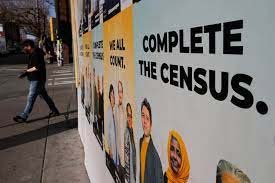In the Bay Area, San Mateo County has the highest Census questionnaire response rates and San Francisco County the lowest
by FT
Internet services
The covid-19 has added to the various problems that the 2020 Census has to properly count all the inhabitants of the country. To date, the response rate is close to what the Census predicted, which is good news, but the question experts are asking is whether the coronavirus could somehow mess up a complete 2020 Census count.
Due to the health emergency caused by the current pandemic, the Census has postponed the exit to the fields of its pollsters. Now it is expected that by the new term, which ends on October 31, they will have taken to the streets to knock on all the doors necessary to complete the questionnaires.
“We want to take care of people’s health. We have time to ensure that all communities are counted…Now people have the option of responding to the Census themselves. They can respond online at 2020.census.gov, or respond via phone or regular mail,” said Keshia Morris Desir, manager of the 2020 Census Campaign and the campaign to end criminalization and mass incarceration of the Common Cause organization.
An incomplete Census and covid-19 have something in common: they mainly affect poor communities. “We are seeing some disparities in the count,” Morris Desir said in a virtual conference. At the California level, the response to the census has been 64% as of the end of July, with no knocking on doors yet. This means 4.2 points below the 2010 Census.
So far this year, Morris Desir said counting problems are already being seen in poor communities. “We have seen some issues come to the fore again especially with those communities that are below the poverty line.” The average response among people living in extreme poverty was 46.9% in June, 14% below the national average. “Unfortunately this crack seems to be slowly getting larger as the Census progresses,” said Morris Desir.
The Census is the basis for distributing funds from government social programs, and “because of the structural inequities in government we are going to see these inequities multiply in all other systems,” said Jonathan Mehta Stein, a civil rights attorney. and executive director of California Common Cause.
Trying to include the citizenship question “was turning the Census into a political weapon” and significantly damaged its credibility, “gave people the impression that the Census could be used for [spying]. Absolutely reduced participation in the Census. Even after that question was thrown out by the Supreme Court,” Stein said.
Activists and critics agree that historically there are many communities that have been undercounted. Particularly the minorities of African Americans, Latinos and Native Americans. In both rural and urban areas, these communities are facing the risk of being undercounted. “But we also know that renters and people living in multi-family housing, single parent households, and separated households with children under the age of five have historically also been undercounted by the Census. This amounts to inequities in political representation not only for ethnic or racial reasons but also for social and economic reasons,” said Morris Desir.
Census data is used to make decisions about how political power and money are distributed equitably. Each year the federal government, guided by Census data, allocates millions of dollars to health, housing assistance programs, lunches, education and others.
The Census also identifies the population to define electoral districts. An act of Congress passed in 1967 requires that representatives of the lower house be elected in and by the constituencies they represent.
For example, in 2015 California received about $55.4 billion from the federal government for health programs, $3.5 billion for housing programs called Section 8, and $1.2 billion for student meal programs. Also, a total of $115,000 million dollars for social programs was given to the state of California according to the information provided by the Census.
“If California undercounts its citizens then it will receive less than its fair share… When communities of color, when communities living in poverty are undercounted, the resources and political representation that they deserve is going away. other more privileged communities,” said Morris Desir.
—
The Census in the Bay
As of July 29, 2020, the highest response rate to the 2020 Census questionnaire in the Bay Area is in San Mateo County at 73.8%, followed by Contra Costa and Santa Clara counties at 72.1%. and 72% respectively, Mari County



